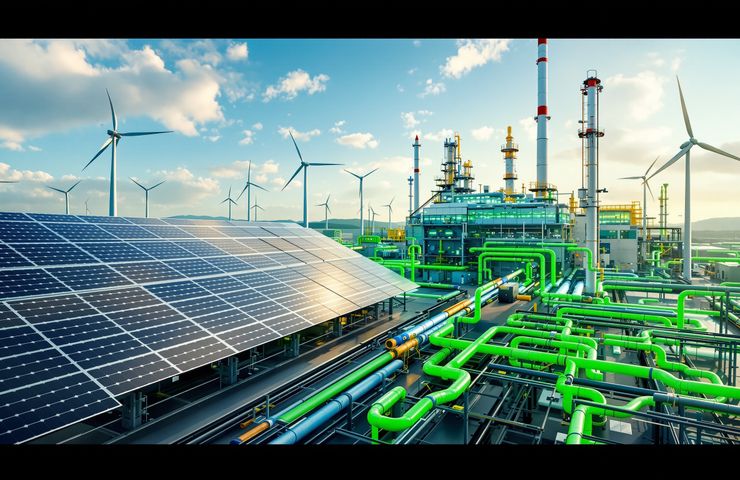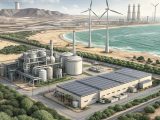
Green Steel Revolution: ACME Group’s ₹5,000 Crore Leap with Green Hydrogen-Powered DRI Plant
October 16, 2025Ever thought steel could be made without that dreaded CO₂ puff? The ACME Group just blew the cobwebs off that question. On October 12, 2025, this Gurugram outfit dropped a bombshell: a ₹5,000 crore push to build a 1.2 MTPA Direct Reduced Iron (DRI) plant to churn out Hot Briquetted Iron (HBI) and Green DRI—all powered by green hydrogen, kicking off a new era of green steel and sustainable steel.
Here’s the Kicker
Since blast furnaces roared to life in the 19th century, steelmaking has been a coal-burning gig. Now, under the leadership of Chairman Manoj Kumar Upadhyay, the ACME Group is flipping that narrative on its head with green steel. Instead of fossil fuels, they’re plugging in hydrogen spun out of sunlight and wind turbines. What that means is drastically slashed emissions for one of the planet’s dirtiest industries. And while ACME’s not yet unveiling every ounce of data, they claim this setup will yield some of the most carbon-light Green DRI and Green HBI you can get your hands on.
ACME Group isn’t a green hydrogen rookie either—they’ve already got 2,700 MW of solar capacity under their belt, along with wind and hybrid setups. Their electrolyzers in Odisha are coming online, and the plant in Oman is almost ready for prime time. By co-locating the new DRI mill alongside these renewable assets, they’re knitting together an end-to-end sustainable steel pipeline, all in one spot.
Timing couldn’t be sweeter. India’s National Green Hydrogen Mission is racing toward huge electrolyzer targets by 2030, and ACME’s DRI project plugs right into that momentum. That could translate into fat subsidies, juicy carbon credits, and a green light from policymakers itching to back sustainable steel pioneers.
Behind the Numbers
- ₹5,000 crore investment: Confirmed by Business Standard, NewsBytes and The Week.
- 1.2 MTPA capacity: A first phase cranking out 1.2 million tonnes of green HBI and DRI.
- Take-or-pay deal: Stavian Industrial Metal locked in 0.8 MTPA over ten years—revenue security, checked.
- Site shortlist: Options in India or Oman, both packing renewable-heavy grids, port access and attractive incentives.
They’ll probably fund this outlay with a blend of internal accruals, bank debt and green financing vehicles. Given ACME’s clean-energy creds, expect lenders to roll out the red carpet on competitive terms.
And that take-or-pay contract not only guarantees a revenue baseline but also pins down a floor price for their green iron, which is pure gold for investors hunting stable returns.
The Magic Ingredient
Everything hinges on that sweet green hydrogen. Picture electrolyzers chipping water molecules apart with wind and solar juice, yielding pure hydrogen and oxygen. That hydrogen then jumps into the DRI reactor, yanking oxygen out of iron ore and leaving behind metallic iron—no carbon plume in sight.
Raw DRI then gets squished into Hot Briquetted Iron (HBI). Think of these dense briquettes as the shipping-friendly, safe-to-handle snacks for electric arc furnaces around the globe—instant, on-demand feedstock.
Bonus point: the freed-up oxygen doesn’t go to waste. It can be piped off to local industries, fattening project economics and minimizing waste.
Power Play
Picking the site for a gig this massive isn’t a snap decision. Odisha scores points for iron-ore access, budding hydrogen infrastructure and sweet policy perks. On the flip side, Oman tempts with rock-bottom energy rates, a growing renewables stack and ports waiting to be busy. ACME’s final call will hinge on cost, grid reliability and how fast they want shipments rolling—think Vietnam-bound cargo.
This move locks in ACME’s end-to-end play: solar farms to electrolyzers to DRI towers. Teaming up with Stavian Industrial Metal lays down the rails for a cross-border green steel highway, well before a single beam lands in a mill.
The Big Picture
To put it in perspective, steelmaking pumps out around 7–9% of the planet’s CO₂. Sure, Europe’s HYBRIT and H2 Green Steel experiments have shown the hydrogen route works, but they’re just sniffing the surface. If ACME nails its 1.2 MTPA launch, India could leapfrog competitors and become a powerhouse of green steel exports.
With the EU’s Carbon Border Adjustment Mechanism turning low-carbon steel into a premium, price-insensitive asset, big automakers and construction heavyweights are circling. They want cleaner feedstock—and India might be primed to deliver.
The spin-offs? Enormous. We’re talking thousands of jobs in construction and operations, a tidal wave of demand for electrolyzers and renewables, and a roadmap for slashing emissions in heavy industry. Coal-reliant mills will either scramble to get on board or get left in the dust.
Global investors are all eyes, too. Billions in climate funds are queued up for deals like this one. ACME’s milestones could signal a floodgate opening for green-tech capital in emerging markets.
Final Shot
So, is this the dawn of a new steel era? It damn well looks like it. The ACME Group is teeing up supply chains and customer commitments before a single shovel hits the dirt. Sure, we’re still waiting on detailed build schedules and exact emission cuts, but the playbook is laid bare: reinvent steelmaking, kick coal to the curb, and fling open the gates to a cleaner future. Strap in!
Circle your calendars—site pick, deal sign-offs, first green hydrogen delivery—those will be the markers to watch. And once this juggernaut hits full stride, ACME could export its Direct Reduced Iron blueprint to Africa, Australia, or Latin America. After all, why stick with coal when you can have cleaner, compliant iron at a better price?


 With over 15 years of reporting hydrogen news, we are your premier source for the latest updates and insights in hydrogen and renewable energy.
With over 15 years of reporting hydrogen news, we are your premier source for the latest updates and insights in hydrogen and renewable energy.